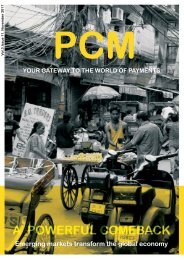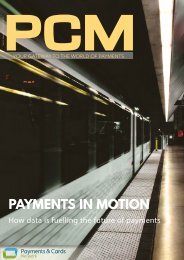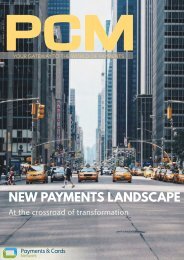PCM Vol.3 Issue 12
In this issue, we will explore the development of eCommerce, the upcoming trends in 2018 and the key challenges eCommerce merchants face trying to keep up with the fast-paced changes.
In this issue, we will explore the development of eCommerce, the upcoming trends in 2018 and the key challenges eCommerce merchants face trying to keep up with the fast-paced changes.
Create successful ePaper yourself
Turn your PDF publications into a flip-book with our unique Google optimized e-Paper software.
The Three Hottest E-commerce Trends of 2017<br />
2017 has seen a reinvigoration of the worldwide<br />
ecommerce market, with the cross-border market<br />
developing faster than domestic online retail. In fact,<br />
the compound annual growth rate predicted for crossborder<br />
ecommerce for 2017 to 2022 now stands at<br />
17%, higher than the <strong>12</strong>% growth rate for ecommerce<br />
overall. Below are some of the most interesting trends<br />
and shifts that are driving the market.<br />
The quicker and more cost-effective option for<br />
dealing with PSD2 is to outsource control of some<br />
or all of your funds to a licensed payment, such as<br />
Acapture - already compliant with PSD2. This way,<br />
marketplaces will not need to make huge system<br />
changes to continue operating as normal. For those<br />
interested, here are some easy-to-read reports on<br />
the implications of PSD2.<br />
1. Online Marketplaces dominate the international scene<br />
In 2017, online marketplaces have continued their rapid<br />
growth worldwide. By 2020, 39% of the world’s entire<br />
ecommerce market will be controlled by marketplaces,<br />
while, already, 53% of cross-border sellers in the US<br />
use online marketplaces. In China, Alibaba Group, the<br />
Asian ecommerce giant whose portfolio of websites<br />
includes the marketplaces Alibaba.com, Taobao and<br />
AliExpress, became Asia’s most valuable company<br />
and by August its market cap had reached USD442<br />
billion. By subverting the traditional retailer consumer<br />
relationship and acting as a link between the buyer<br />
and the seller, online marketplaces have created a<br />
level of security and usability for all involved parties<br />
that would be very difficult to establish otherwise. For<br />
emerging merchants looking to move cross-border,<br />
an established marketplace offers all the tools<br />
they need.<br />
2. Consumer technologies driving growth of<br />
eCommerce<br />
While consumer technology is making the buyer<br />
more accessible to the merchant, it is also<br />
making the buyer more demanding, with a greater<br />
expectation for personalized shopping experiences<br />
and flawless logistics.<br />
To deliver such services, the big brands are utilizing<br />
the most popular technology trends, of which these<br />
five are the most prominent: data science, AI and<br />
machine learning, virtual reality, blockchain and the<br />
Internet of Things (IoT).<br />
In 2018, marketplace operators<br />
will be heavily affected by the<br />
revised Payment Services<br />
Directive (PSD2), which<br />
obliges any operator that, at<br />
any stage in a transaction,<br />
is handling another party’s<br />
money to be licensed as a<br />
payment institution, with<br />
all that it entails from a<br />
financial, regulatory and<br />
operational angle.

















